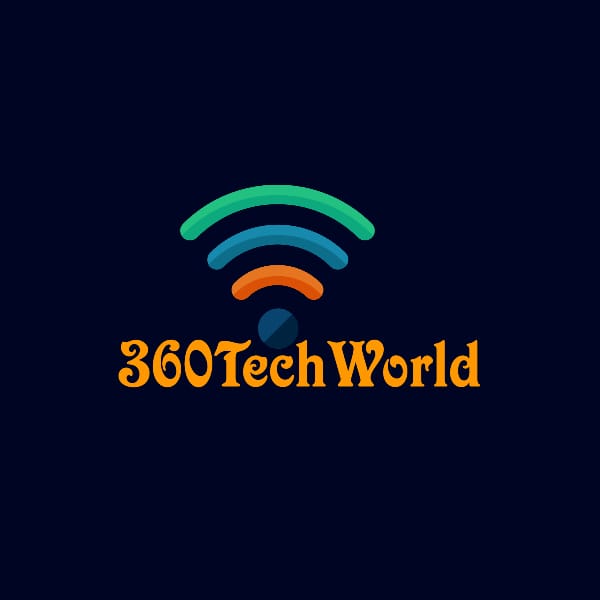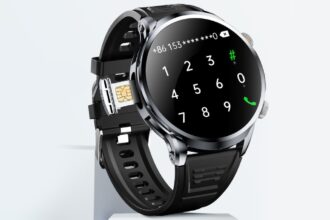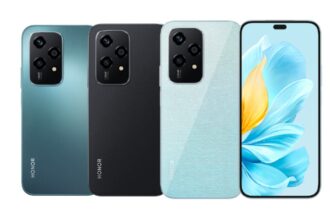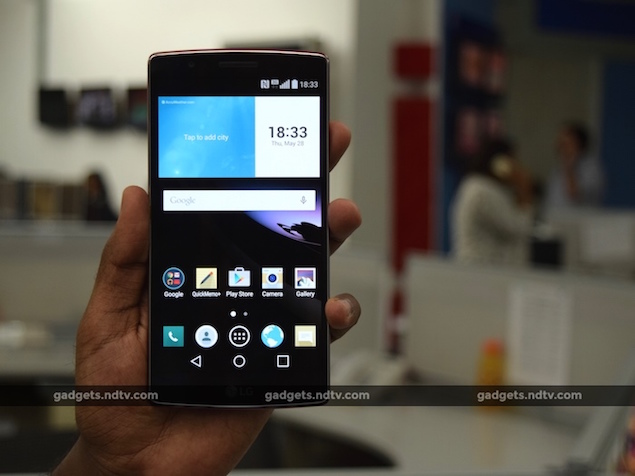After hearing about user complaints, the company decided to go back to the drawing board and this year LG launched the upgraded version, the G Flex2. The phone is smaller than its predecessor and features a 1080p display. There are also several improvements to the handset. For instance, the back of the phone gets a self-healing coating. The Gorilla Glass screen protection is much better. Apart from this, the G Flex2 is the first smartphone to feature Qualcomm’s latest and greatest octa-core 64-bit SoC, the Snapdragon 810 processor. Is the LG G Flex2 a better curvy version? Let’s find out.
![]()
Look and design
Like the older version, the design of G Flex2 is also very unique and the credit for this goes to the curvy style. During the review, we found that after seeing this phone, people were forced to turn around, that is, the handset worked to arouse curiosity. Especially the Flamingo Red color handset, which we got for review. However, the phone is also available in silver color. Compared to the older version, G Flex2 is more light, slim, compact, it can be used with a single hand. However, this does not mean that this phone is more suitable for operating with one hand.
LG has used a self-healing coating (G Flex also had this feature) on the back of the phone, which means that once a scratch appears on the body, it heals automatically. Due to the slimy texture of this coating, we lost grip of this phone many times. LG claims that the self-healing feature works in just 10 seconds. If a scratch appears at room temperature, it will recover in 10 seconds. This is much less than the 3-minute rating of G Flex. We also tried scratching the back of the phone and it healed very quickly, but the 10-second claim is nothing short of an exaggeration.
![]()
By applying pressure to the rear side of the phone, the G Flex2 bent and returned to its original shape much faster than the previous variant. Like the LG G2, G3 and G Flex, the power button in the G Flex2 is also placed on the rear side between the volume control buttons. The texture pattern of the volume buttons is quite different from the power button, which makes them easy to recognize. The tactile feedback is also quite good. The primary camera is placed above it. Along with this, there is a dual LED flash and laser autofocus window.
The front of the phone has a 700mm radius curvature, while the rear has a 650mm radius curvature due to the side grip. The G Flex 2 has a 5.5-inch screen and the company has provided onscreen buttons to navigate the operating system. The earpiece, LED indicator, front camera and ambient light sensor are built above the display.
![]()
Specifications and software
The phone uses a powerful Qualcomm Snapdragon 810 octa-core processor. It also supports four ARM Cortex-A53 cores at 1.5GHz and four Cortex-A57 cores at 2GHz. Adreno 430 GPU is also part of the SoC. The G Flex2 model available in India comes with 2GB RAM and 16GB internal storage. According to the company, the storage can be expanded up to 2TB via microSD card. There is no need to get too excited about this feature, because only microSD cards up to 128GB are available in the market.
![]()
The phone has many sensors, such as an accelerometer, gyroscope, proximity sensor and a compass. The biggest drawback of this phone is the lack of support for 4G networks available on the 2300MHz band. Due to this, most 4G networks in India cannot be accessed through this phone. In terms of connectivity, the phone has support for Wi-Fi a/b/g/n/ac, Bluetooth v4.1 with aptX and Infrared LG. LG has used a 13-megapixel rear camera. It comes with optical image stabilization. Support for laser autofocus and dual LED flash is also available for the primary camera. When you flip the phone, you will find that there is a 2.1-megapixel camera on the front of the phone. LG was forced to reduce the size and capacity of the battery due to providing a compact body. G Flex 2 has a 3000mAh battery, while in the previous variant it was 3500mAh. The phone’s 5.5-inch P-OLED panel has a resolution of 1080p. The screen of the latest handset is more crisp and vibrant compared to G Flex. Due to the screen being curved, the content gets a 3D look to some extent. The experience of watching videos, reading long articles and playing games on the curved screen is great. This is the real advantage of having a curved screen. The viewing angles are also excellent and there is less reflection on the phone even in sunlight.
![]()
The G Flex 2 runs Google’s Android 5.0 Lollipop operating system and LG has used its own custom UI on top of it. The custom UI is very clean and has a flat look, but it is by no means identical to Android Lollipop. LG has kept the unwanted bloatware to a minimum, which is great. A software feature called Glance allows users to view the status bar and recent notifications by swiping down from the top of the screen even when the phone is locked. KnockCode (customized code to unlock the phone) and KnockOn (double tap to activate the screen), features that LG has already launched in its phones, are also available on this handset.
Camera
To everyone’s surprise, LG has removed many features from the default camera app, now only three modes are available – Auto, Panorama and Dual. The Dual Mode app allows users to create picture in picture images using both cameras at once, but it’s not that innovative.
![]()
The 13-megapixel camera captures images with great detail and natural colours. It focuses on the subject very quickly. However, some people may not find the images as colourful as they would like. We noticed barrel distortion around the edges, which was very disappointing. The HDR mode does a good job of preventing the image from being overexposed in bright light.
![]()
In low light, the rear camera works well. We took some detailed shots, but the camera failed to reduce noise. OIS does help. The OIS system comes in handy to avoid shooting shaky videos. The quality of the 4K videos we shot was excellent, but sadly, the camera limits the clip length to 5 minutes. The quality of selfies taken with the 2.1-megapixel front camera was average. However, you can make your picture more beautiful using the in-built beauty mode.
![]()
Performance
Given the controversies, we were excited to test the Snapdragon 810 SoC. We also found that it has heating issues. The phone heats up even when performing a slightly demanding task. The upper part of the rear side of the phone heats up even when taking photos. Also, simple tasks like swiping down the notification shade often stutter due to processor throttling. This kind of shortcoming is unlikely to occur in a flagship device.
![]()
For those who are interested, we have the benchmark scores, but don’t go by these numbers alone to judge the G Flex 2’s capabilities. In AnTuTu and Quadrant tests, the handset managed to score 49,882 and 29,223 respectively, which is impressive. Living up to expectations, the phone managed a score of 17,358 in 3DMark Ice Storm’s Basic test.
The G Flex2 played our video test file with ease. The sound quality on the loudspeaker was poor. The earphones provided with the phone produce good sound and you won’t need to replace them. The sound quality was also quite good during phone calls and the phone managed to maintain a connection on congested networks. In the battery test, the phone lasted 8 hours and 6 minutes, which is less than the performance of the G Flex. Perhaps, the company’s decision to use a smaller battery is wrong. Even during normal use, we found that the battery life was not very good.
![]()
Our verdict
LG’s attempt to make a curved smartphone for the general user seems to be failing, this time the reason is the performance of the processor. It is not that the phone will not get users due to this shortcoming, but knowing that the price of this phone is around Rs 50,000, such small shortcomings are more bothersome.
The G Flex2 is worth buying for its uniqueness. Practically speaking, if you are willing to spend that much, we would suggest you check out the iPhone 6 or the Samsung Galaxy S6 as well. We would even recommend the second version of the Galaxy S6, the Galaxy S6 Edge, as it is a more stable product.





